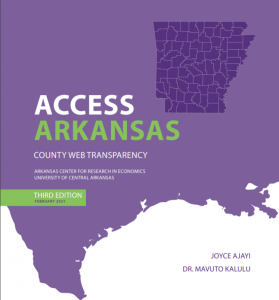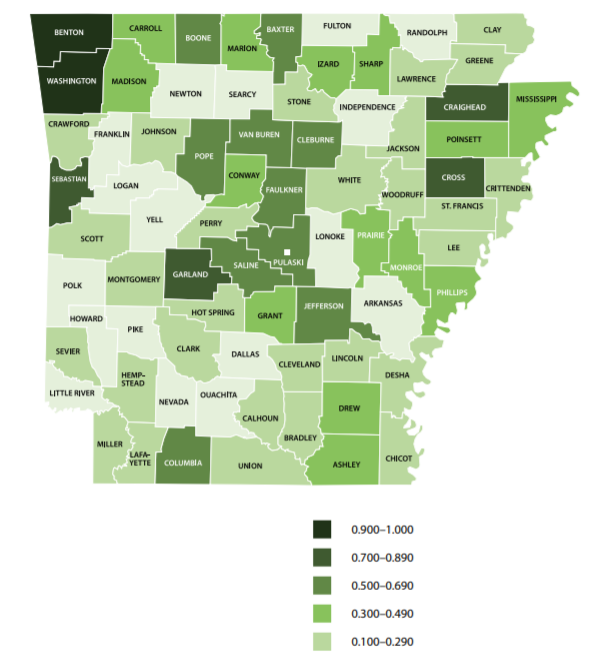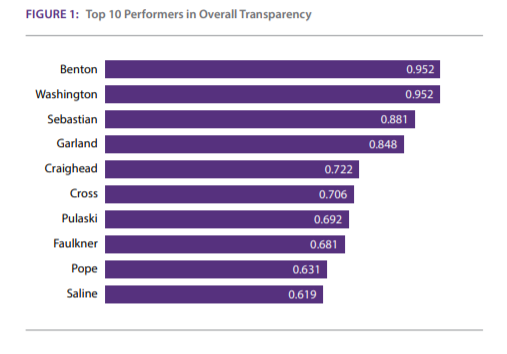By Caleb Taylor
What counties are leading the rest of the state when it comes to online transparency in 2020?
You can find out through the just-released third annual “Access Arkansas: County Web Transparency” from the Arkansas Center for Research in Economics, co-authored by ACRE Policy Analysts Joyce Ajayi and Dr. Mavuto Kalulu.
Improvement
The index’s authors begin the report by noting improvement on overall transparency scores since the previous report.
In 2018, counties published about 15 percent of the important public information included in the ACRE index. In 2019 they published about 21 percent. In 2020, they published about 31 percent.
That means the amount of information available online about county governments has more than doubled since the inaugural edition of the ACRE index.
Ajayi and Kalulu write:
The current index shows that, on average, Arkansas counties are publishing about 31 percent of the important information included in our index compared to about 21 percent in 2019 and 15 percent in 2018. We acknowledge that one factor contributing to the improvement could be that we had more researchers searching for information on the county websites this year than we did in the previous two years. This increase in our research resources may have increased our chances of finding the information. However, we attribute the improvement mainly to two other factors.”
In the 2018 edition of the report, Kalulu, Ajayi and ACRE Program Coordinator Terra Aquia suggested state legislators consider requiring county governments to post their budgets online by amending state law. Act 564, passed into law in March, 2019 does just that. The law requires all Arkansas counties to post their annual budget on a website owned or maintained by the county, the state, or the Association of Arkansas Counties. Counties are already required to publish such information in their local newspaper.
Ajayi and Kalulu write:
The law states that beginning in January 2020, counties must publish financial information on web platforms, including Facebook. This law has improved fiscal transparency. We commend the law’s lead sponsor, Rep. Spencer Hawks (R-District 70), for his efforts toward the achievement. We also commend the Association of Arkansas Counties for providing an alternative web platform for publishing county financial information.”
Since the inaugural edition of the transparency index in 2018, many counties have taken the initiative to improve their online transparency.
Ajayi and Kalulu write:
The publication of our report has encouraged counties to involve us in their transparency efforts. For example, Faulkner County engaged our policy analysts to testify in favor of an ordinance to publish contract bidding information online. Benton County invited us to discuss specific areas where the county can improve transparency. Over the last year, we interacted with several county officials inquiring how they could enhance their counties’ transparency. As a result, we are pleased to report that several counties have made tremendous web transparency improvements.”
The index ranks all Arkansas counties by how much financial, political and administrative information their websites contain.
Top 10 Most Web-Transparent Counties
In 2018 and 2019, Washington County garnered the highest online transparency score. In 2020, Washington tied with Benton County for the top score.
Ajayi and Kalulu write:
Scoring highest on all three types of transparency, Benton County (0.952) and Washington County (0.952) stand out as the most web-transparent counties in Arkansas, as figure 1 shows. While there used to be a noticeable gap between Washington County and Arkansas’s other 74 counties, some counties have made improvements to shrink that gap.”
Ajayi and Kalulu also note that “compared to 2019, Benton County has improved by 0.190 points, which means that it publishes 19 percent more information online than last year.”
Ajayi and Kalulu write:
Last year, only eight counties—Washington, Benton, Garland, Sebastian, Pulaski, Faulkner, Saline, and Columbia—had an overall score greater than 0.500. The current index shows that all top 10 counties have a score greater than 0.500. Three of these counties—Craighead, Cross, and Pope—scored below 0.500 last year. Less encouraging is that 79 percent of Arkansas counties (59 out of 75) still score less than 0.500, which means these counties are publishing less than 50 percent of the important public information included in our index. Thus, despite the improvements some counties have made, most counties still have a long way to go to improve their web transparency. A possible reason for not publishing information may include a lack of resources and personnel with knowledge of how to do so. However, a 2018 United States Public Interest Research Group report notes that as technology improves, governments may be able to lower the costs of creating and maintaining their websites. Despite this possible barrier, counties should consider that a transparent government’s benefits, such as improved relationships between government officials and residents, will likely outweigh the costs of developing online resources.”
You can read the entire third edition of “Access Arkansas: County Web Transparency” here.
For more of our research on transparency, go here.



